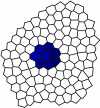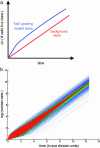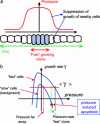Mechanical feedback as a possible regulator of tissue growth
- PMID:15728365
- PMCID: PMC552900
- DOI: 10.1073/pnas.0404782102
Mechanical feedback as a possible regulator of tissue growth
Abstract
Regulation of cell growth and proliferation has a fundamental role in animal and plant development and in the progression of cancer. In the context of development, it is important to understand the mechanisms that coordinate growth and patterning of tissues. Imaginal discs, which are larval precursors of fly limbs and organs, have provided much of what we currently know about these processes. Here, we consider the mechanism that is responsible for the observed uniformity of growth in wing imaginal discs, which persists in the presence of gradients in growth inducing morphogens in spite of the stochastic nature of cell division. The phenomenon of "cell competition," which manifests in apoptosis of slower-growing cells in the vicinity of faster growing tissue, suggests that uniform growth is not a default state but a result of active regulation. How can a patch of tissue compare its growth rate with that of its surroundings? A possible way is furnished by mechanical interactions. To demonstrate this mechanism, we formulate a mathematical model of nonuniform growth in a layer of tissue and examine its mechanical implications. We show that a clone growing faster or slower than the surrounding tissue is subject to mechanical stress, and we propose that dependence of the rate of cell division on local stress could provide an "integral-feedback" mechanism stabilizing uniform growth. The proposed mechanism of growth control is not specific to imaginal disc growth and could be of general relevance. Several experimental tests of the proposed mechanism are suggested.
Figures





Similar articles
- Scaling morphogen gradients during tissue growth by a cell division rule.Averbukh I, Ben-Zvi D, Mishra S, Barkai N.Averbukh I, et al.Development. 2014 May;141(10):2150-6. doi: 10.1242/dev.107011.Development. 2014.PMID:24803660
- Histological analysis of the dynamics of growth of imaginal discs and histoblast nests during the larval development ofDrosophila melanogaster.Mandaravally Madhavan M, Schneiderman HA.Mandaravally Madhavan M, et al.Wilehm Roux Arch Dev Biol. 1977 Dec;183(4):269-305. doi: 10.1007/BF00848459.Wilehm Roux Arch Dev Biol. 1977.PMID:28304865
- Cell cycle progression, growth and patterning in imaginal discs despite inhibition of cell division after inactivation of Drosophila Cdc2 kinase.Weigmann K, Cohen SM, Lehner CF.Weigmann K, et al.Development. 1997 Sep;124(18):3555-63. doi: 10.1242/dev.124.18.3555.Development. 1997.PMID:9342048
- The genetic control of cell proliferation in Drosophila imaginal discs.Bryant PJ, Schmidt O.Bryant PJ, et al.J Cell Sci Suppl. 1990;13:169-89. doi: 10.1242/jcs.1990.supplement_13.16.J Cell Sci Suppl. 1990.PMID:2084115Review.
- Growth control in the Drosophila wing disk.Gou J, Stotsky JA, Othmer HG.Gou J, et al.Wiley Interdiscip Rev Syst Biol Med. 2020 May;12(3):e1478. doi: 10.1002/wsbm.1478. Epub 2020 Jan 9.Wiley Interdiscip Rev Syst Biol Med. 2020.PMID:31917525Review.
Cited by
- Mechanisms of cell competition: themes and variations.Levayer R, Moreno E.Levayer R, et al.J Cell Biol. 2013 Mar 18;200(6):689-98. doi: 10.1083/jcb.201301051.J Cell Biol. 2013.PMID:23509066Free PMC article.Review.
- When Size Matters: New Insights on How Seed Size Can Contribute to the Early Stages of Plant Development.Boccaccini A, Cimini S, Kazmi H, Lepri A, Longo C, Lorrai R, Vittorioso P.Boccaccini A, et al.Plants (Basel). 2024 Jun 28;13(13):1793. doi: 10.3390/plants13131793.Plants (Basel). 2024.PMID:38999633Free PMC article.Review.
- On the mechanism of wing size determination in fly development.Hufnagel L, Teleman AA, Rouault H, Cohen SM, Shraiman BI.Hufnagel L, et al.Proc Natl Acad Sci U S A. 2007 Mar 6;104(10):3835-40. doi: 10.1073/pnas.0607134104. Epub 2007 Feb 28.Proc Natl Acad Sci U S A. 2007.PMID:17360439Free PMC article.
- Photo-elastic properties of the wing imaginal disc of Drosophila.Schluck T, Aegerter CM.Schluck T, et al.Eur Phys J E Soft Matter. 2010 Oct;33(2):111-5. doi: 10.1140/epje/i2010-10580-8. Epub 2010 May 28.Eur Phys J E Soft Matter. 2010.PMID:20563622
- Physical model of the dynamic instability in an expanding cell culture.Mark S, Shlomovitz R, Gov NS, Poujade M, Grasland-Mongrain E, Silberzan P.Mark S, et al.Biophys J. 2010 Feb 3;98(3):361-70. doi: 10.1016/j.bpj.2009.10.022.Biophys J. 2010.PMID:20141748Free PMC article.
References
- Sean, B. Carroll, S. W. & Grenier, J. (2000) From DNA to Diversity: Molecular Genetics and the Evolution of Animal Design (Blackwell Science, Oxford).
- Gerhart, J. & Kirschner, M. (1997) Cells, Embryos, and Evolution: Towards a Cellular and Developmental Understanding of Phenotypic Variation and Evolutionary Adaptability (Balckwell Science, Oxford).
- Day, S. J. & Lawrence, P. A. (2000) Development (Cambridge, U.K.) 127, 2977-2987. - PubMed
- Conlon, I. & Raff, M. (1999) Cell 96, 235-244. - PubMed
Publication types
MeSH terms
Grants and funding
LinkOut - more resources
Full Text Sources
Other Literature Sources
Molecular Biology Databases
